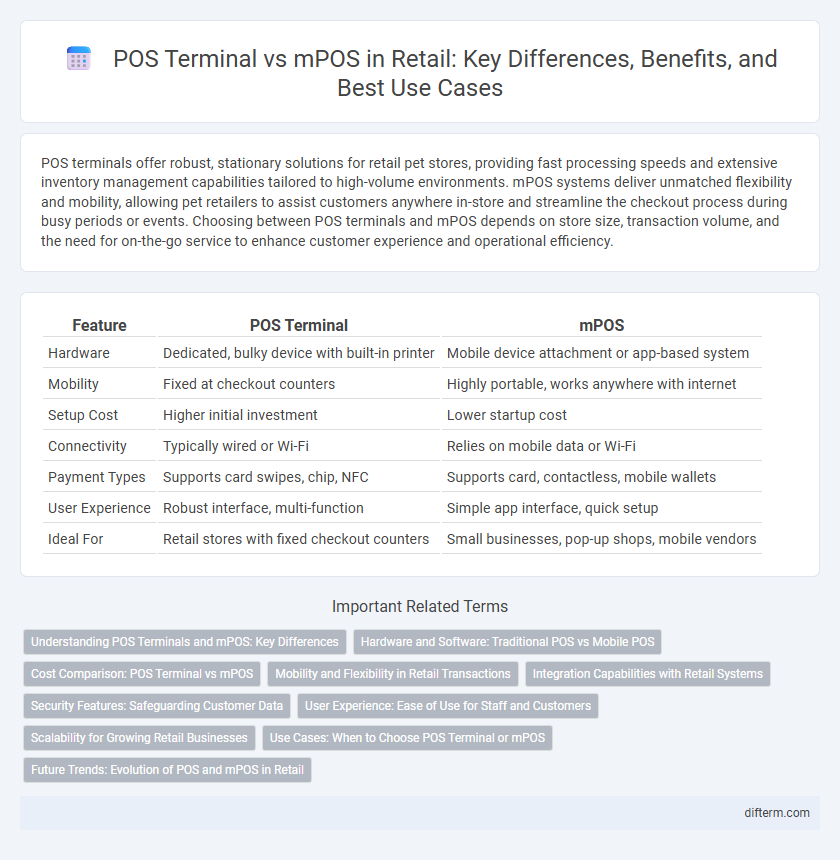POS terminals offer robust, stationary solutions for retail pet stores, providing fast processing speeds and extensive inventory management capabilities tailored to high-volume environments. mPOS systems deliver unmatched flexibility and mobility, allowing pet retailers to assist customers anywhere in-store and streamline the checkout process during busy periods or events. Choosing between POS terminals and mPOS depends on store size, transaction volume, and the need for on-the-go service to enhance customer experience and operational efficiency.
Table of Comparison
| Feature | POS Terminal | mPOS |
|---|---|---|
| Hardware | Dedicated, bulky device with built-in printer | Mobile device attachment or app-based system |
| Mobility | Fixed at checkout counters | Highly portable, works anywhere with internet |
| Setup Cost | Higher initial investment | Lower startup cost |
| Connectivity | Typically wired or Wi-Fi | Relies on mobile data or Wi-Fi |
| Payment Types | Supports card swipes, chip, NFC | Supports card, contactless, mobile wallets |
| User Experience | Robust interface, multi-function | Simple app interface, quick setup |
| Ideal For | Retail stores with fixed checkout counters | Small businesses, pop-up shops, mobile vendors |
Understanding POS Terminals and mPOS: Key Differences
POS terminals are traditional, stationary devices used at retail checkouts to process payments quickly and securely, featuring integrated hardware like barcode scanners and receipt printers. In contrast, mPOS systems utilize mobile devices or tablets with card readers, offering portability and flexibility for on-the-go transactions. Understanding these key differences helps retailers choose the right solution based on store size, transaction volume, and customer interaction needs.
Hardware and Software: Traditional POS vs Mobile POS
Traditional POS terminals feature robust hardware with integrated cash registers, barcode scanners, and receipt printers, designed for brick-and-mortar retail environments requiring stable, high-volume transaction processing. Mobile POS (mPOS) systems leverage smartphone or tablet hardware paired with cloud-based software, offering agility, ease of use, and real-time inventory updates through wireless connectivity. Software for traditional POS often includes comprehensive, on-premise management solutions, while mPOS platforms prioritize app-based interfaces and seamless integration with e-commerce and CRM systems.
Cost Comparison: POS Terminal vs mPOS
POS terminals typically involve higher upfront costs due to hardware purchase and installation fees, whereas mPOS systems leverage existing mobile devices, reducing initial expenses significantly. Ongoing costs for POS terminals include maintenance and software licensing, while mPOS solutions often operate on subscription models with lower monthly fees and minimal hardware upkeep. Small and medium-sized retailers benefit from mPOS cost flexibility, while larger businesses may justify POS terminal investments through scalability and integrated features.
Mobility and Flexibility in Retail Transactions
POS terminals offer robust hardware with fixed installation, making them ideal for stationary retail environments but limiting mobility. mPOS systems leverage smartphones or tablets, providing enhanced flexibility for on-the-go sales and improving customer engagement through mobile checkouts. Retailers benefit from mPOS solutions by enabling seamless transactions anywhere in-store or off-site, boosting operational efficiency and customer satisfaction.
Integration Capabilities with Retail Systems
POS terminals offer robust integration capabilities with retail systems, supporting advanced inventory management, customer relationship management (CRM), and loyalty programs through direct hardware-software interfaces. mPOS solutions, powered by mobile apps and cloud connectivity, provide flexible integration with cloud-based retail platforms and real-time data synchronization, enhancing omnichannel retail experiences. Retailers benefit from POS terminals' stability in high-volume environments, while mPOS excels in adaptability for pop-up stores and outdoor events.
Security Features: Safeguarding Customer Data
POS terminals incorporate advanced encryption protocols and hardware-based security modules to protect customer data during transactions, ensuring compliance with PCI DSS standards. mPOS devices employ tokenization and secure cloud-based authentication to safeguard sensitive information while enabling mobile, flexible payment solutions. Both systems prioritize end-to-end encryption and regular security updates to mitigate cyber threats and maintain transaction integrity.
User Experience: Ease of Use for Staff and Customers
POS terminals offer a robust and familiar interface for staff, ensuring quick transaction processing and minimal training time, which enhances operational efficiency. mPOS devices provide a flexible and intuitive experience for both staff and customers, enabling seamless mobile payments and faster checkouts in diverse retail environments. The choice between POS and mPOS directly impacts user satisfaction, with mPOS excelling in mobility and ease of use, while traditional POS ensures stability and comprehensive functionality.
Scalability for Growing Retail Businesses
POS terminals offer robust hardware and software integration designed for scalability in large retail environments, supporting extensive product catalogs and multiple payment types. mPOS solutions provide flexible, mobile scalability ideal for growing businesses needing quick deployment, remote transaction processing, and real-time inventory management. Both systems enhance operational efficiency, but mPOS excels in adapting to expanding store footprints and dynamic retail settings.
Use Cases: When to Choose POS Terminal or mPOS
POS terminals are ideal for brick-and-mortar stores requiring robust, stationary systems with comprehensive inventory management and fast transaction processing. mPOS solutions excel in mobile environments such as pop-up shops, trade shows, and delivery services where portability and wireless connectivity are crucial. Businesses focusing on customer interaction outside traditional storefronts benefit from mPOS, while those needing integrated hardware and higher security often choose POS terminals.
Future Trends: Evolution of POS and mPOS in Retail
The future of retail POS terminals and mPOS systems centers on increased integration of AI-driven analytics and contactless payment technologies, enhancing transaction speed and personalized customer experiences. Cloud-based solutions and IoT connectivity will enable real-time inventory management and seamless omnichannel retail strategies. Emerging trends also emphasize mobility and security, with mPOS devices becoming more prevalent in enabling flexible, secure checkout options across diverse retail environments.
POS Terminal vs mPOS Infographic

 difterm.com
difterm.com